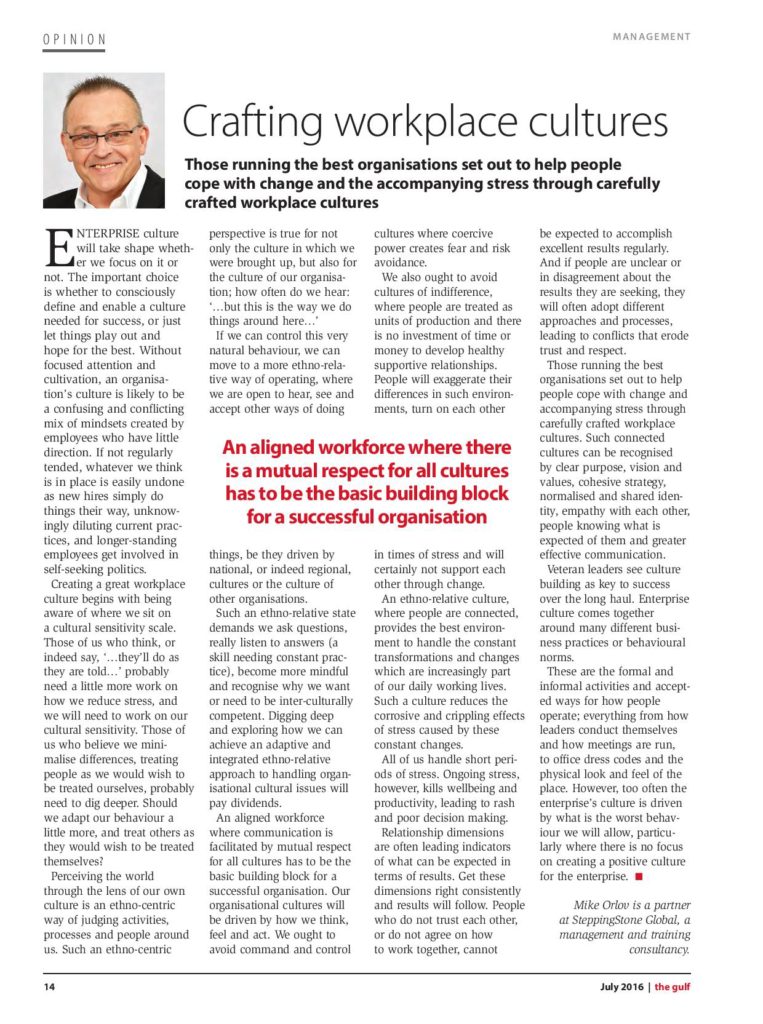
Enterprise culture will take shape whether we focus on it or not. The important choice is whether to consciously define and enable a culture needed for success, or just let things play out and hope for the best. Without focused attention and cultivation, an organization’s culture is likely to be a confusing and conflicting mix of mindsets created by employees who have little direction. If not regularly tended, whatever we think is in-place is easily undone as new hires simply do things their way, unknowingly diluting current practices, and longer-standing employees get involved in self-seeking politics.
Creating a great workplace culture begins with being aware of where we sit on a cultural-sensitivity scale. Those of us who think, or indeed say, ‘…they’ll do as they are told…’ probably need a little more work on how we reduce stress, and we will need to work on our cultural sensitivity. Those of us who believe we minimalize differences, treating people as we would wish to be treated ourselves, probably need to dig deeper. Should we adapt our behavior a little more, and treat others as they would wish to be treated themselves?
None of us arrives in this world inter-culturally aware; people do not build this competence just because they live and work in a multicultural environment. Becoming inter-culturally competent is a developmental process, one taking time and effort, working at sublimating our own perceptions and really attempting to get into the shoes of others so we can treat them as they would wish to be treated themselves.
Perceiving the world through the lens of our own culture is an ethno-centric way of judging activities, processes and people around us. Such an ethno-centric perspective is true for not only the culture in which we were brought up, but also for the culture of our organization; how often do we hear these words: ‘…but this is the way we do things around here…’
If we can control this very natural behavior, we can then move to a more ethno-relative way of operating, where we are open to hear, see and accept other ways of doing things, be they driven by national, or indeed regional, cultures or the culture of other organizations.
Such an ethno-relative state demands we ask questions, really listen to the answers (a skill in itself needing constant practice), become more mindful and recognize why we want or need to be inter-culturally competent. Digging deep and exploring how we can achieve an adaptive and integrated ethno-relative approach to handling organizational cultural issues will pay dividends.
An aligned workforce where communication is facilitated by mutual respect for all cultures has to be the basic building-block for a successful organization. Our organizational cultures will be driven by how we think, feel and act. We ought to avoid command and control cultures where coercive power creates fear and risk-avoidance.
We also ought to avoid cultures of indifference, where people are treated as units of production and there is no investment of time or money to develop healthy supportive relationships. People will exaggerate their differences in such environments, turn on each other in times of stress and will certainly not support each other through change.
An ethno-relative culture, where people are connected, provides the best environment to handle the constant transformations and changes which are increasingly part of our daily working lives. Such a culture reduces the corrosive and crippling effects of stress caused by these constant changes.
All of us handle short periods of stress. Ongoing stress, however, kills wellbeing and productivity, leading to rash and poor decision making. It is no surprise we instinctively attempt to avoid stress caused by change.
Relationship dimensions are often leading indicators of what can be expected in terms of results. Get these dimensions right consistently and results will follow. People who do not trust each other, or do not agree on how to work together, cannot be expected to accomplish excellent results regularly. And if people are unclear or in disagreement about the results they are seeking, they will often adopt different approaches and processes, leading to conflicts that erode trust and respect.
Those running the best organizations set out to help people cope with change and the accompanying stress through carefully crafted workplace cultures. Such connected cultures can be recognized by clear purpose, vision and values, cohesive strategy, normalized and shared identity, empathy with each other, people knowing what is expected of them and greater levels of effective communication. We can all develop better tools for amending cultures and actioning more effective ways of working, creating less stress within the workforce and higher levels of productivity.
Veteran leaders see culture building as key to success over the long haul. Enterprise culture comes together around many different business practices or behavioral norms; as already mentioned, ‘…the way things are done around here’. These are the formal and informal activities and accepted ways for how people operate; everything from how leaders conduct themselves and how meetings are run, to office dress codes and the physical look and feel of the place. However, too often the enterprise’s culture is driven by what is the worst behavior we will allow, particularly where there is no focus on creating a positive culture for the enterprise.
